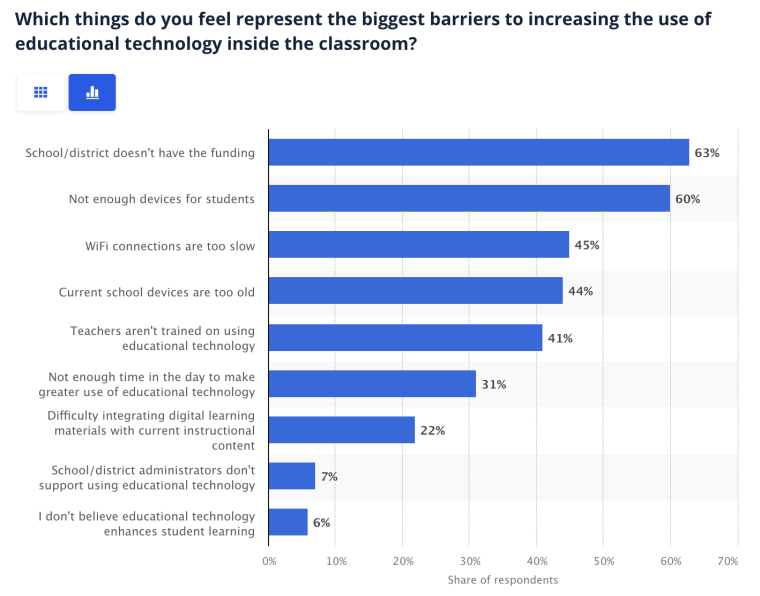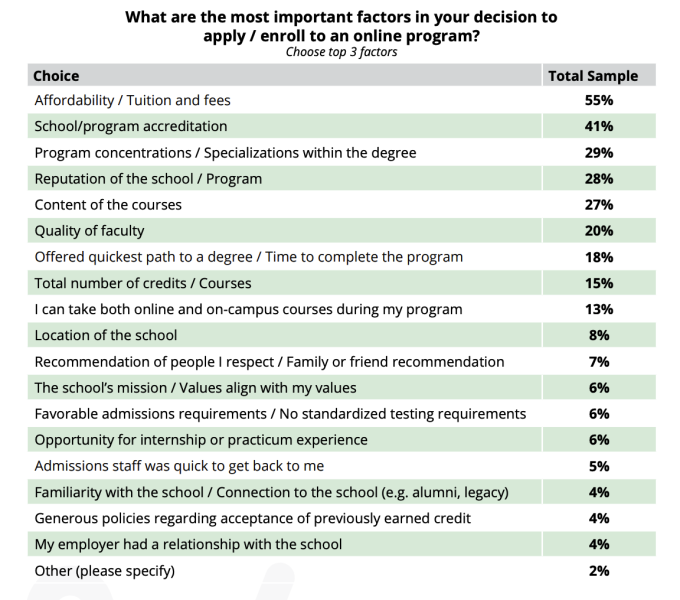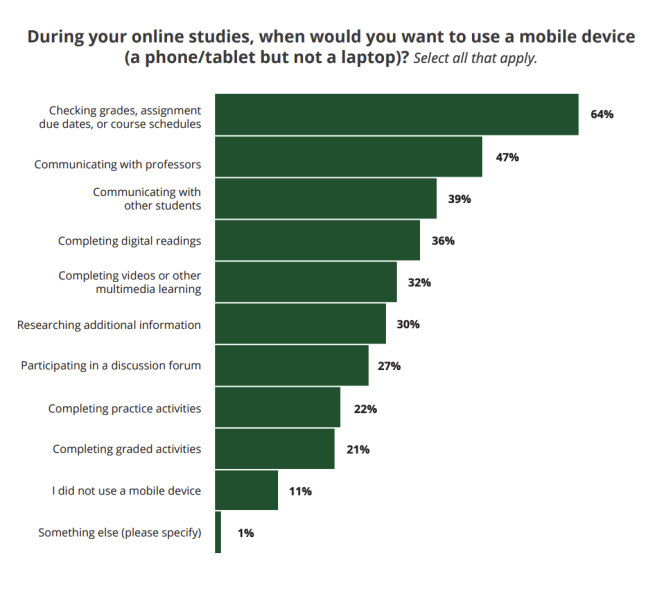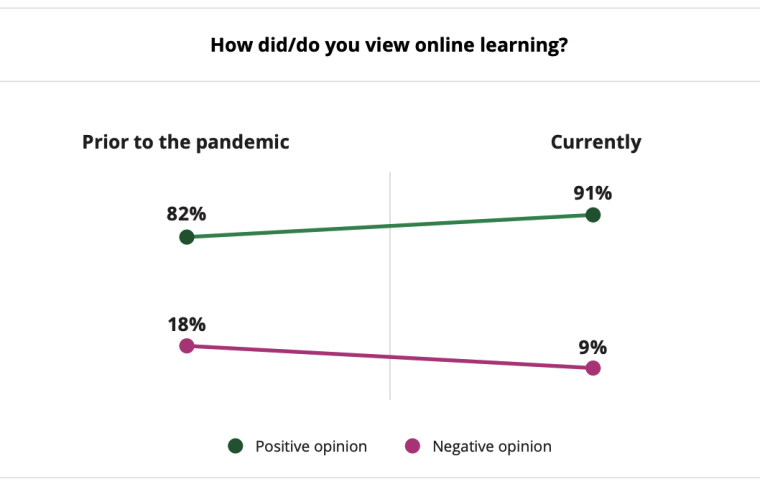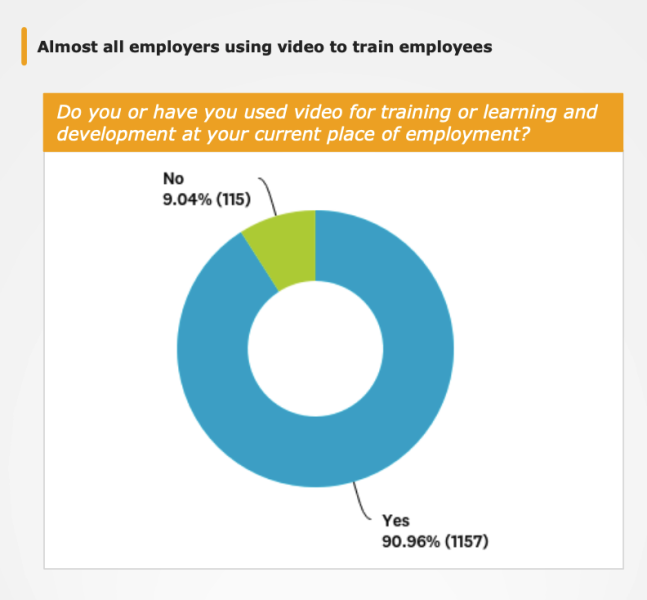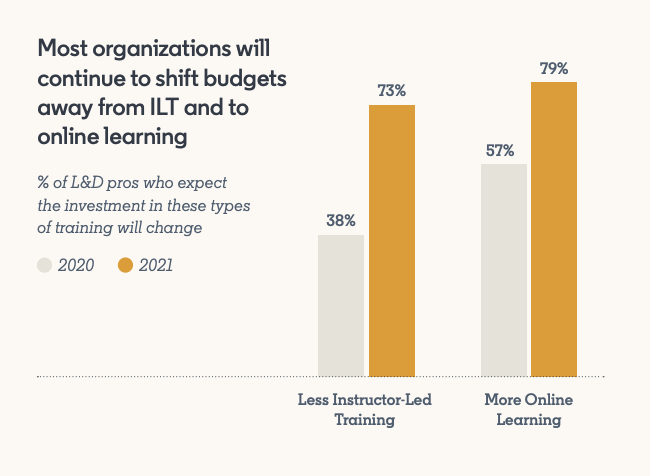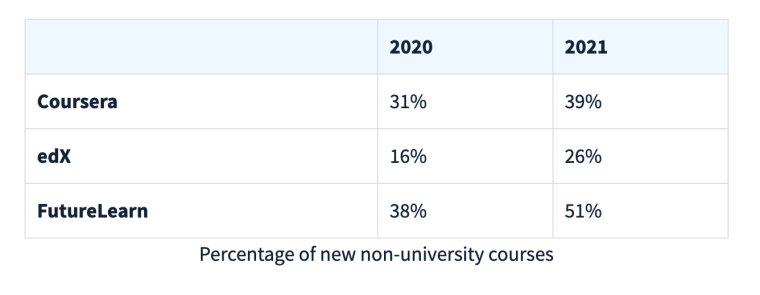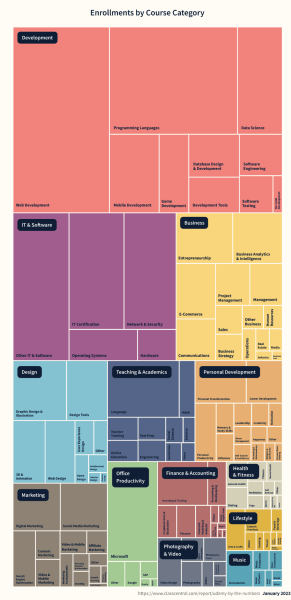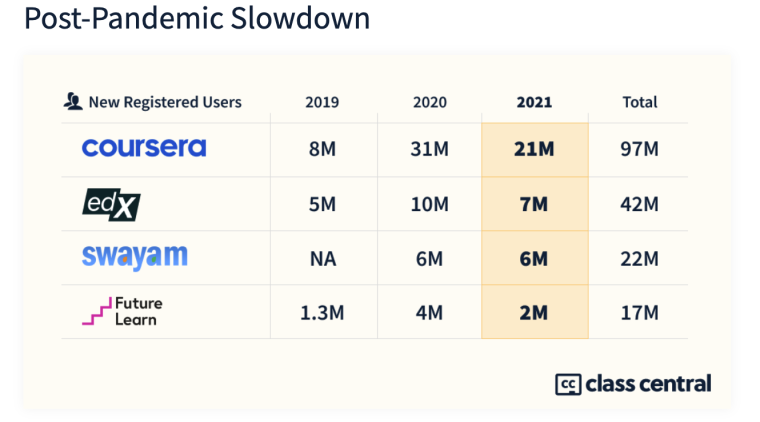In today’s fast-paced digital era, e-learning has emerged as a crucial tool for both businesses and individuals seeking continuous growth and development.
The convenience, accessibility, and flexibility of e-learning have revolutionized traditional education methods, making it an indispensable resource for staying competitive and adaptive in various industries.
Fear not, as we have compiled a carefully curated list of essential e-learning statistics for 2025, bringing together all of the most valuable insights into one comprehensive resource.
Key Takeaways: The E-learning Evolution As per a survey conducted in 2019, approximately 63% of high school students in the US utilized digital learning tools on a daily basis for their educational activities while at school. In contrast, around 45% of elementary students engaged in similar digital learning practices. In the corporate world, 41.7% of the most profitable companies listed in the Fortune 500 are currently using e-learning tools for online training. Early adopters of this technology see huge savings in the amount of time and money it takes to train (or retrain) employees, while their employees retain more from the actual sessions. Massive open online classes (MOOCs) have swiftly engaged 380 million learners worldwide within a decade, steering towards credentials, credit courses, and degrees. Even before the global pandemic in 2020, online education was booming, providing top-notch learning content worldwide. In the fall of 2006, there were 3.48 million online post-secondary students in the United States, reflecting a growth of 9.7% from the previous year. From 2002, the number of online students had more than doubled by 2006. The growth from 1.6 million students in the fall of 2002 to 3.48 million in the fall of 2006 signified a compound annual growth rate of 21.5% In 2016, educators and administrators from colleges and universities were interviewed on the value of video conferencing. The insights gathered revealed the following: The respondents also pinpointed the top three applications for video collaboration in the educational context: A 2016 survey involving 3,300 college students in the US revealed that 81% of students in the US witnessed grade improvements through e-learning. 81% of students also reported that e-learning improved their efficiency and effectiveness. Around two-thirds (69%) of students also said that e-learning helped to boost their concentration. In another 2016 survey, 41% of participating US teachers identified insufficient training as the foremost barrier to expanding the use of edtech in their classrooms. The other reasons included inadequate funding (63%), a shortage of devices for students (60%), slow WiFi (45%), and outdated school devices (44%). In a 2021 survey, 55% of students identified affordability as the third leading reason for selecting an online school. The survey involved 1,530 college students enrolled or enrolling in an online program. Following cost, the most important factor was the accreditation of the school or program (41%). Other top factors included: Before the COVID-19 pandemic, it was estimated that approximately 5% to 8% of K-12 students were participating in online learning. This situation prompted the shift to emergency remote teaching in March 2020, while the majority of students and teachers lacked familiarity and readiness for online education. As of spring 2020, 80% of K-12 educators had enhanced their proficiency in employing e-learning technology. This shift signifies that educators became more adept at leveraging e-learning tools, enabling them to achieve comparable student outcomes through this technology. In the fall of 2020, 75% (11.8 million) of undergraduates took at least one distance education course, with 44% (7 million) exclusively in such courses. The enrollment of undergraduates in any distance education course in 2020 increased by 97% from fall 2019 (11.8 million vs. 6 million). Exclusive enrollment in distance education courses by undergraduates in 2020 rose 186% from 2019 (7 million vs. 2.4 million). Based on a 2021 report, 21% of surveyed students express the desire to carry out all their course-related tasks using mobile devices. More than half (51%) reported that they would prefer to engage in at least some course-related activities via mobile devices. Millennials and Gen Y, having grown up with technology, demonstrated a higher affinity for mobile-based learning. The age factor significantly influenced learning preferences. When it comes to mobile device use, 64% of students are interested in checking grades and due dates. 47% want to communicate with professors, while 39% prefer interacting with classmates. Engaging in class activities like discussion forums and practice tasks on mobile devices also appeals to a number of online learners, although it ranks lower on the list. Around 57% of students in the US exhibit increased optimism toward e-learning compared to pre-COVID times. Prior to the pandemic, online college courses mainly attracted older adults managing various life commitments while pursuing degrees. However, the pandemic shifted perceptions, leading to enhanced opinions about online learning among students due to widespread exposure to online courses. A 2021 survey revealed a student preference for online courses post-pandemic at 76%, while 64% prefer the option to take a mix of in-person and online courses. Conducted by Bay View Analytics on behalf of several educational organizations, the survey gathered insights from 1,469 students and 1,286 faculty/administrators across 856 US institutions. Three-quarters of students currently enrolled in online courses wished for the opportunity to take additional online courses in the future. During 2021, 30.3% of US higher education students exclusively pursued distance learning courses. 27.9% of students engaged in partial distance learning. Both these cohorts experienced a decrease from the prior year, showing the decline of the pandemic’s impact. According to a 2023 report, 1 in 3 online learners between 2020 and 2023 hadn’t considered online learning before the pandemic. 59% of students who enrolled in online programs during this period plan to continue with online learning. 18% of learners are likely to switch to campus-based programs in the future, with 16% very likely. About a third of learners considered transferring to campus-based programs. Motivations for transferring include wanting more peer interaction (49%) and following in-person plans (36%). Overall, positive opinions of online learning increased from 82% pre-pandemic to 91%. Negative opinions about online learning decreased by half. In 2022, Western Governors University in Utah had the highest number of students (136,139) enrolled exclusively in distance learning courses in the US. Following closely, Southern New Hampshire University ranked second, with an exclusive online enrollment of 106,375 students. The global corporate e-learning industry was worth around $22.5 billion in 2021. It’s expected to keep expanding, with an average yearly growth of about 10.5%. By 2028, it’s predicted to hit nearly 45 billion U.S. dollars in value. According to a study from 2019, 82% of enterprise workers found interactive videos more effective in holding their attention compared to non-interactive ones. The research also revealed that while encouraging employees to focus on training and e-learning videos can be tough, about 72% of the workforce admitted to not fully paying attention. However, the findings suggest that incorporating interactive elements can help improve attention levels. 91% of employees have used videos for training and learning at their current workplace. Over 90% of respondents have embraced video as a means of learning specific skills in their work environment. Despite Gen Z’s familiarity with videos, other generations are also adopting this approach. Rates of video adoption for learning new skills are nearly equal across different generations. The prevalence of high-quality video experiences from platforms like Netflix and Hulu has raised the bar for expectations in the workplace. E-Learning consumes 40% to 60% less time compared to traditional, instructor-led training. Traditional training methods like instructor-led training often involve substantial time commitments and travel expenses. E-learning saves employees from such disruptions, allowing them to dedicate more time to their job tasks and responsibilities. Learning and development (L&D) professionals are allocating 57% of their efforts to e-learning, according to Linkedin’s findings. The pandemic has led to a rise in the popularity of online learning due to its cost-effectiveness, interactive technology, and learner flexibility. These factors have collectively transformed education, shifting our learning methods and diminishing the relevance of traditional classroom training. At the beginning of 2020, 38% of L&D professionals anticipated reduced spending on instructor-led training (ILT) while 57% projected increased investment in online learning. Presently, these figures have escalated: 73% of L&D pros foresee decreased spending on ILT, and 79% predict greater expenditure on online learning. In 2020, only 36% of organizations used webinars or virtual classrooms, according to the UK-based Chartered Institute of Professional Development. In 2021, the percentage of organizations using these online mediums had risen to 51%. However, organizations have been slow to adopt new technologies (e.g., mobile apps, chatbots, VR, and AR), which promise to enhance engagement. The massive open online courses (MOOC) market is projected to reach $64,034 billion by 2029. This growth is anticipated to be driven by a CAGR of 36.7%. MOOCs reached 220 million learners, excluding China in 2021. In the same year, providers launched over 3,100 courses and 500 micro-credentials. In 2021, 40 million new learners signed up for at least one MOOC, compared to 60 million (fueled by the pandemic) in 2020. Back in 2011, more than 300,000 students participated in the inception of the modern MOOC movement through three complementary courses offered by Stanford University. These courses, hosted on Coursera, garnered enrollment from individuals representing 190 countries and played a role in the emergence of MOOCs. Coursera paved the way for platforms such as edX and Udacity. Among those who initially enroll in a MOOC program, around one-third to half don’t engage in any active manner. Of those who engage in at least one activity, 5-10% proceed to successfully earn a certificate. In 2021, a decade after its emergence, the MOOC ecosystem has grown to encompass 19,400 courses. Initially, MOOC providers leaned heavily on universities to develop courses. However, this reliance is diminishing as an increasing number of courses are now generated by companies annually. This group includes industry leaders such as Google, Microsoft, Amazon, and Facebook. Regarding new learners post-pandemic, the boost has somewhat subsided. In 2021, approximately 40 million new learners enrolled in at least one MOOC, in contrast to 60 million in 2020. 1960s: The concept of computer-assisted learning (CAL) emerges, using early computers to deliver educational content. 1970s: PLATO (Programmed Logic for Automatic Teaching Operations) system pioneers interactive computer-based learning. 1980s: Apple’s pioneering computer is introduced in American classrooms during the 1980s. Apple kickstarted the “Kids Can’t Wait” initiative in 1983, donating numerous Apple IIe desktops to Californian schools. 1990s: The internet becomes more accessible, giving rise to web-based e-learning platforms and early Learning Management Systems (LMS). 2001: MIT launches OpenCourseWare, offering free online access to course materials from various disciplines. 2002: Over 1.6 million students in the United States enroll in at least one online course. 2005: YouTube’s launch facilitates the sharing of educational videos and becomes a valuable learning asset. 2008: Massive open online courses gain prominence with platforms like Coursera and edX offering free online courses from prestigious universities. 2011: Khan Academy introduces a new model of online learning with short video lessons and interactive exercises. 2012-3: The first three learning experience platforms (LXPs) emerge – Degreed, Edcast, and Pathgather – marking the inception of this product category. 2015: 87% of college and university students frequently use laptops for their studies, often complemented by the use of smartphones, tablets, or hybrid devices. 2019: Zoom, initially a video conferencing tool, gains popularity for virtual classrooms and remote learning. 2020: The COVID-19 pandemic accelerates the adoption of e-learning, prompting universities, schools, and businesses to shift to online learning. 2021: The adoption of e-learning continues to surge, with over 1.6 billion students worldwide affected by school closures due to the COVID-19 pandemic. 2022: The pandemic positively shifts students’ perception of remote education, with 94% of Wiley survey respondents now holding a favorable view compared to 86% before, and negative views decreased from 14% to 6%. Zoom Video Communications, commonly known as Zoom, was founded in 2011 by Eric Yuan. Initially, it was developed as a video conferencing solution. However, it gained immense popularity, especially during the COVID-19 pandemic, as a tool for remote work, online meetings, and virtual events. Zoom extended its assistance to 90,000 schools in 20 countries at the beginning of the global pandemic, aiding remote education for children. To contextualize this expansion, by December 2019, the highest daily meeting participants on Zoom were around 10 million. However, in March 2020, Zoom surpassed 200 million daily users (a 2,000% increase) for both free and paid meetings. In a 2022 study, a quantitative descriptive analysis of student responses indicated that Zoom Meeting implementation for online learning in elementary schools is effective, with a 72.5% student understanding rate. The study used purposive survey methodology, involving data triangulation from tests, questionnaires, and unstructured interviews. The sample comprised 160 randomly selected students who filled out online questionnaires. Zoom Video Communication experienced a growth of nearly 7.5% in revenue during their fiscal year 2023 as compared to the preceding fiscal year. For the fiscal year concluding on January 31st, 2023, Zoom achieved approximately $4.4 billion in revenue. Udemy was founded in 2009 by Eren Bali, Oktay Caglar, and Gagan Biyani. It aimed to provide a platform for individuals to create and share online courses on a wide range of topics. As of June 2023, the platform had a user base of 64 million learners, offering upwards of 210,000 courses taught by over 75,000 instructors in nearly 77 languages. There have been over 870 million course enrollments on the platform. In 2020, with the shift toward remote work becoming the prevailing norm, the results demonstrated a surge in demand worldwide across all sectors: Courses on Udemy are accessible in a diverse range of 77 languages, with the majority, around 59%, being provided in English. The other most common languages on the platform include: Udemy’s most popular courses are in technology and business, making up 74.6% of the total courses on the platform. Other subjects include: Coursera was founded in 2012 by Andrew Ng and Daphne Koller. It partnered with top universities to offer high-quality online courses and degrees. Starting from mid-March 2020, Coursera experienced a surge with over 21 million new learners joining the platform. This increase marks an uplift of 353% when compared to the corresponding period in the previous year. During that time, the platform witnessed another uptick, with over 50 million course enrollments, showcasing a 444% increase. Thousands of higher education institutions have integrated Coursera into their educational framework, providing an enhanced learning journey for their students. Coursera outperformed its closest MOOC competitors in sustaining its pandemic-related growth. As of 2020, the countries with the most learners on Coursera included: By learner growth, the top-5 countries on the platform are: In 2022, Coursera announced over 100 million registered users worldwide on its 10-year anniversary. In the same year, Coursera also introduced several new features and initiatives: Lynda.com, which later became LinkedIn Learning after its acquisition by LinkedIn, was founded in 1995 by Lynda Weinman and Bruce Heavin. It focused on providing video tutorials for software, creative, and business skills. Industry experts approximate that Lynda’s user base exceeds 5.4 million individuals. The platform is set to become accessible to LinkedIn’s expanding worldwide community of over 347 million members. In Ontario, Canada, during the academic year 2018-2019, approximately 80,000 students, faculty members, and staff members from Ontario’s post-secondary institutions made use of the complimentary access to a collection of video tutorials offered by Lynda.com. Approximately 60% of the 80,000 individuals who used the platform were affiliated with colleges, while the remaining 40% were associated with universities. A minority, constituting less than a quarter of users, successfully finished an entire course. A small subset of users (4%) was responsible for nearly a quarter (24%) of all course completions. E-learning’s evolution is reshaping educational and professional development landscapes, offering scalable, cost-effective solutions that cater to a diverse global audience. This mode of learning is not just a trend but a fundamental shift in how knowledge is acquired and applied.E-learning Statistics Highlights

Types of Online Learning Statistics
Academic E-learning
Academic E-Learning During and Post-Pandemic
Corporate Training E-learning
Online Course E-learning
The Evolution of E-learning
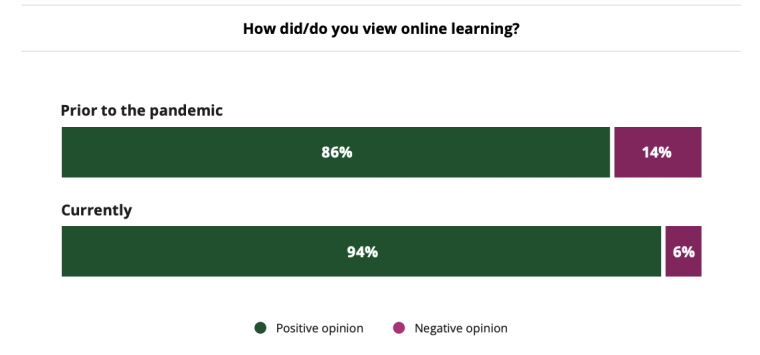
E-learning and Learning Management System (LMS) Statistics
Zoom
Udemy
Coursera
Country
Number of Learners (millions)
The US
14
India
9.8
Mexico
3.8
China
3.5
Brazil
3
Lynda
Final Thoughts: E-learning Statistics
FAQs
How effective is online learning?
What is the growth rate of online learning?
What is the next generation of LMS?
References
